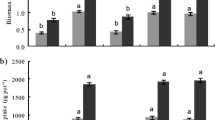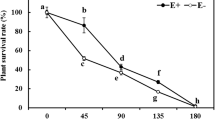Abstract
Tall fescue (Festuca arundinacea Schreb.) plants infected by the fungal endophyte Neotyphodium coenophialum (Morgan-Jones & Gams) (Glenn et al., 1996) often perform better than noninfected plants, especially in marginal resource environments. There is a lack of information about endophyte related effects on the rhizosphere of grasses. In a greenhouse experiment, four endophyte-infected (E+) tall fescue clones (DN2, DN4, DN7, DN11) and their endophyte-free (E−) forms were grown in limed (pH 6.3) Porter soil (low fertility, acidic, high aluminum and low phosphorus content, coarse-loamy mixed mesic Umbric Dystrochrept) at three soil P levels (17, 50, and 96 mg P kg-1 soil) for five months. Excluding the genotype effect, endophyte infection significantly increased cumulative herbage DM yield by 8% at 17 mg P kg-1 soil but reduced cumulative herbage DM yield by 12% at 96 mg P kg-1 soil. With increased P availability in the soil, shoot and root DM, and root/shoot ratio in E+ plants were significantly less when compared to E− plants. Endophyte infection increased specific root length at 17 and 50 mg P kg-1soil. At soil P level of 17 mg P kg-1soil, E+ plants had significantly higher P concentrations both in roots and shoots. Similar relationships were found for Mg and Ca. E+ plants had significantly higher Zn, Fe, and Al concentration in roots, and lower Mn and Al concentration in shoots when compared to E− plants. Ergot alkaloid concentration and content in shoot of E+ plants increased with increasing P availability in the soil from 17 to 50 mg P kg-1 but declined again at 96 mg P kg-1 soil. Ergot alkaloid accumulation in roots increased linearly with P availability in the soil. Results suggest that endophyte infection affects uptake of phosphorus and other mineral nutrients and may benefit tall fescue grown on P-deficient soils. Phosphorus seems also to be involved in ergot alkaloid accumulation in endophyte-infected tall fescue.
Similar content being viewed by others
References
Arachavaleta M, Bacon C W, Hoveland C S and Radcliffe D E 1989 Effect of tall fescue endophyte on plant response to environmental stress. Agron. J. 81, 83–91.
Arechavaleta M, Bacon C W, Plattner R D, Hoveland C S and Radcliffe D E 1992 Accumulation of ergopeptide alkaloids in endophyte-infected tall fescue grown under deficits of soil water and nitrogen fertilizer. Appl. Environ. Microbiol. 58, 857–861.
Azevedo M D 1993 Studies on the fungal endophyte Acremonium coenophialum in tall fescue. Ph.D. Thesis. Oregon State University.
Azevedo M D and Welty R E 1995 A study of the fungal endophyte Acremonium coenophialum in the roots of tall fescue seedlings. Mycologia 87, 289–297.
Bacon C W 1993 Abiotic stress tolerances (moisture, nutrients) and photosynthesis in endophyte-infected tall fescue. In Proc. Int. Symp. on Acremonium/Grass Interactions. Eds. S S Quisenberry and R E Joost. pp. 123–141. 5–7 Nov. 1990, New Orleans, LA.
Bacon C W and De Battista J 1991 Endophytic fungi of grasses. In Handbook of Applied Mycology. Eds. D K Arora, B Rai, K G Mukerji and G R Knudsen. pp 231–256. Marcel Dekker, Inc., New York.
Belesky D P, Devine O J, Pallas J E Jr, Stringer W C 1987 Photosynthetic activity of tall fescue as influenced by a fungal endophyte. Photosynthetica 21, 82–87.
Belesky D P and Fedders J M 1995 Tall fescue development in response to Acremonium coenophialum and soil acidity. Crop Sci. 35, 529–533.
Belesky D P and Fedders J M 1996 Does endophyte influence regrowth of tall fescue? Ann. Bot. 78, 499–505.
Belesky D P, Stringer W C and Hill N S 1989 Influence of endophyte and water regime upon tall fescue accessions: I. Growth characteristics. Ann. Bot. 63, 495–503.
Belesky D P, Stuedemann J A, Plattner R D and Wilkinson S R 1988 Ergopeptine alkaloids in grazed tall fescue. Agron. J. 80, 209–212.
Cheplick G P, Clay K and Marks S 1989 Interactions between infection by endophytic fungi and nutrient limitation in the grasses Lolium perenne and Festuca arundinacea. New Phytol. 111, 89–97.
Clay K 1994 The potential role of endophytes in ecosystems. In Biotechnology of Endophytic Fungi of Grasses. Eds. C W Bacon and J F White, Jr. pp 73–99. CRC Press, Inc., Boca Raton, FL.
De Battista J P, Bacon C W, Severson R, Plattner R D and Bouton J H 1990a Indole acetic acid production by the fungal endophyte of tall fescue. Agron. J. 82, 878–880.
De Battista J P, Bouton J H, Bacon C W and Siegel M R 1990b Rhizome and herbage production of endophyte removed tall fescue clones and populations. Agron. J. 82, 651–654.
Flieger M, Sedmera P, Novak J, Cvak L, Zapletal J and Stuchlik J 1991 Degradation products of ergot alkaloids. J. Nat. Prod. 54, 390–395.
Flores H E, Weber C and Puffet J 1996 Underground plant metabolism: The biosynthetic potential of roots. In Plant Roots: The Hidden Half. 2nd ed. Eds. Y Waisel, A Eshel and U Kafkafi. pp 931–935. Marcel Dekker, Inc., New York.
Garner G B, Rottinghaus G E, Cornell C N and Testereci H 1993 Chemistry of compounds associated with endophyte/grass interaction: ergovaline-and ergopeptine-related alkaloids. Agric. Ecosyst. Environm. 44, 65–80.
Glenn A E, Bacon C W, Price R and Hanlin R T 1996 Molecular phylogeny of Acremonium and its taxonomic implications. Mycologia 88, 369–383.
Hanson A A 1979 The future of tall fescue. In Tall Fescue. Eds. R C Buckner and L P Bush. pp. 341–344. Agron. Monogr. 20. ASA, CSSA, SSSA, Madison, WI.
Hill N S and Agee C S 1994 Detection of ergoline alkaloids in endophyte-infected tall fescue by immunoassay. Crop Sci. 34, 530–534.
Hill N S, Belesky D P and Stringer W C 1991a Competitiveness of tall fescue as influenced by Acremonium coenophialum. Crop Sci. 31, 185–190.
Hill N S, Parrot W A and Pope D D 1991b Ergopeptine alkaloid production by endophytes in a common tall fescue genotype. Crop Sci. 31, 1545–1547.
Hill N S, Stringer W C, Rottinghaus G E, Belesky D P, Parrot W A and Pope D D 1990 Growth, morphological and chemical component responses of tall fescue to Acremonium coenophialum. Crop Sci. 30, 156–161.
Hinton D M and Bacon C W 1985 The distribution and ultrastructure of the endophyte of toxic tall fescue. Can. J. Bot. 63, 36–42.
Joost R E 1995 Acremonium in fescue and ryegrass: Boon or bane. A review. J. Anim. Sci. 73, 881–883.
Kingston H M and Jassie L B 1988 Introduction to Microwave Sample Preparation. Am. Chem. Soc., Washington, D.C. 263 p.
Lapeyrie F F, Chilvers G A and Douglass P A 1984 Formation of metachromatic granules following phosphate uptake by mycelial hyphae of an ectomycorrhizal fungus. New Phytol. 98, 345–360.
Latch G C M 1993 Physiological interactions of endophytic fungi and their hosts. Biotic stress tolerance impared to grasses by endophytes. In Proc Int. Symp. on Acremonium/Grass Interactions. Eds. S S Quisenberry and R E Joost. pp 143–156. 5–7 Nov. 1990, New Orleans, LA.
Latch G C M, Hunt W F and Musgrave D R 1985 Endophytic fungi affect growth of perennial ryegrass. N.Z. J. Agric. Res. 28, 165–168.
Lyons P C, Plattner R D and Bacon C W 1990 Occurrence of peptide and clavine ergot alkaloids in tall fescue. Science 232, 487–489.
Maclean B M, Matthew C and latch G C M 1993 The effect of endophyte on drought resistance in tall fescue. In Proc 2nd Int. Symp. on Acremonium/Grass Interactions. Eds. D E Hume, G C M Latch and H S Easton. pp 165–169. 4–6 Feb. 1993, Palmerston North, New Zealand.
Marks S, Clay K and Cheplick G P 1991 Effects of fungal endophytes on interspecific and intraspecific competition in the grasses Festuca arundinacea and Lolium perenne. J. Appl. Ecol. 28, 194–204.
Marschner H 1986 Mineral nutrition in higher plants. Academic Press Inc., London. 674 p.
Olsen S R and Sommers L E 1982 Phosphorus. In Methods of Soil Analysis. Part 2. Ed. A L Page. Agronomy 9, 403–430.
Peters E J and Zam A H B M 1981 Allelopatic effects of tall fescue genotypes. Agron. J. 73, 56–58.
Richardson M D, Bacon C W and Hoveland C S 1990 The effect of the endophyte removal on gas exchange in tall fescue. In Proc. Int. Symp. on Acremonium/Grass Interactions. Eds. S S Quisenberry and R E Joost. pp 189–193. 3 Nov. 1990, Louisiana Agric. Exp. Stn., Baton Rouge, LA.
Robbers J E 1984 The fermentative production of ergot alkaloids. In Advances in Biotechnological Processes, Vol 3. Eds. A Mizrahi and A L van Wezel. p 197. A R Liss, New York.
Rottinghaus G E, Garner G B, Cornell C N and Ellis J L 1991 HPLC method for quantitating ergovaline in endophyte-infested tall fescue: seasonal variation of ergovaline in stems with leaf sheaths, leaf blades, and seed heads. J. Agric. Food Chem. 39, 112–115.
Schmidt D 1993 Effects of Acremonium uncinatum and a Phialophora-like endophyte on vigour, insect and disease resistance of meadow fescue. In 2nd Int. Symp. on Acremonium/Grass Interactions. Eds. D E Hume, G C M Latch and H S Easton. pp 185–187. 4–6 Feb. 1993, Palmerston North, New Zealand.
Siegel M R, Jarlfors U, Latch G C M and Johnson M C 1987 Ultrastructure of Acremonium coenophialum, Acremonium lolii, and Epichloe typhina endophytes in host and nonhost Festuca and Lolium species of grasses. Can. J. Bot. 65, 2357–2367.
Sleper D A, Garner G B, Nelson C J and Sebaugh J L 1980 Mineral concentration of tall fescue genotypes grown under controlled conditions. Agron. J. 72, 720–722.
West C P, Izekor E, Turner K E and Elmi A A 1993 Endophyte effects on growth and persistence of tall fescue along a water-supply gradient. Agron. J. 85, 264–270.
White J A and Brown M R 1979 Ultrastructure and x-ray analysis of phosphorus granules in a vesicular-arbuscular mycorrhizal fungus. Can. J. Bot. 57, 2812–2818.
White R H, Engelke M C, Morton S J, Johnson-Cicalese J M and Ruemmele B A 1992 Acremonium endophyte effects on tall fescue drought tolerance. Crop Sci. 32, 1392–1396.
Wilhelm W W and Nelson C J 1978 Growth analysis of tall fescue genotypes differing in yield and leaf photosynthesis. Crop Sci. 18, 951–954.
Wright R J, Baligar V C and Wright S F 1987 The influence of acid soil factors on the growth of snapbeans in major Appalachian soils. Commun. Soil Sci. Plant Anal. 18, 1235–1252.
Author information
Authors and Affiliations
Rights and permissions
About this article
Cite this article
Malinowski, D., Belesky, D., Hill, N. et al. Influence of phosphorus on the growth and ergot alkaloid content of Neotyphodium coenophialum-infected tall fescue (Festuca arundinacea Schreb.). Plant and Soil 198, 53–61 (1998). https://doi.org/10.1023/A:1004279401196
Issue Date:
DOI: https://doi.org/10.1023/A:1004279401196




